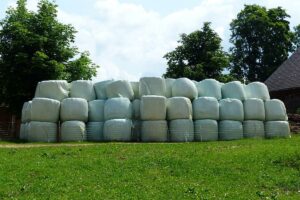Andrés Haro
Enteric fermentation of ruminants is the main source of methane in the dairy industry that constitutes a loss of energy and contributes to greenhouse gas emissions. Direct quantification of greenhouse gas today is complex and requires high accuracy. Therefore, researchers are taking immediate action to reduce its impact.
Among the different methods used to indirectly measure methane enteric emissions in dairy cattle are predictions from the analysis of fatty acid profiles in milk, an easy method to be used in the field.
Bittante and Bergamaschi (2020) used a method based on the analysis of milk fatty acid profile to estimate enteric methane emissions from lactating dairy cows. Milk samples were obtained of 12 farms from 148 lactating cows of 4 dairy breeds (Brown Swiss, Holstein Friesian, Simmental, and Rendena) milked twice a day.
Individual samples obtained during milk processing were whole milk from the morning and evening milkings, and partially skimmed and refrigerated milk from the night milking. In addition, the following dairy products were evaluated: cream, whey, scotta (byproduct of ricotta cheese manufacture), two long-ripening cheeses (6 and 12 months) and ricotta cheese.
The whey from cheese manufacturing was catalyzed with vinegar to obtain ricotta. Samples were taken from a total of 11 milk and dairy product samples from each of the cheese making sessions for analysis of quality parameters and fatty acid profiles (six fatty acids were used for estimating enteric emissions: C4:0, C16:0 iso, C18:1 trans10, C18:1 trans11, C18:1 cis9, C18:2 cis9, cis 12).
Methane enteric emissions were estimated according to equations for methane production (CH4/DMI: i.e. emission in g/kg of dry matter intake, DMI) and the concentration of methane production (CHCH4/ECM, emission per unit of milk corrected for fat and protein (ECM).
The fatty acid C16:0 iso was positively correlated with estimates of enteric emissions
The samples of whole, skimmed and partially skimmed milk had higher proportions of oleic acid (mean value: 24.6% of fatty acids, AG) unlike all reference milks, which had lower content (average value: 23.3% AG), with the exception of whey (24.1% AG).
Differences in the proportions of oleic acid did not affect estimates of enteric emissions, since oleic acid was not included in the equation that predicted methane production. The most predictive fatty acid was C16:0 iso, which was the only positively correlated with estimates of enteric emissions. Only cream and scotta contained a higher proportion of this fatty acid compared to whey and cheeses.
Cream, ricotta, fresh cheese and scotta had a slightly higher C4:0 content than the reference milk. The content of linoleic acid did not differ from the content in reference milk, as a result of changes in the proportions of the six fatty acids. In addition, there were no differences between the estimates of enteric emissions for both methane production and concentration, and samples of fresh cheese, ricotta and whey.
The production of methane per kg of dry matter consumed by cows was overestimated in the cream (17.91 g/kg), but not per kg of ECM. Both enteric emission measurement parameters were overestimated in the scotta (17.48 and 11.95 for methane production and concentration, respectively). Similarly, production and concentration were also overestimated in mature cheeses at 6 and 12 months (17.63 and 12.16 g/kg at 6 months and 17.70 and 12.11 g/kg at 12 months), respectively.
The milk fatty acid profile offers an easy and fast method of estimating enteric methane emissions. In addition, different dairy products and by-products can be used.
References:
Bittante, G., Bergamaschi, M. 2020. Enteric Methane Emissions of Dairy Cows Predicted from Fatty Acid Profiles of Milk, Cream, Cheese, Ricotta, Whey, and Scotta. Animals. 10(1): 61.
© 2020 Dairy Research Review. All Rights Reserved.









